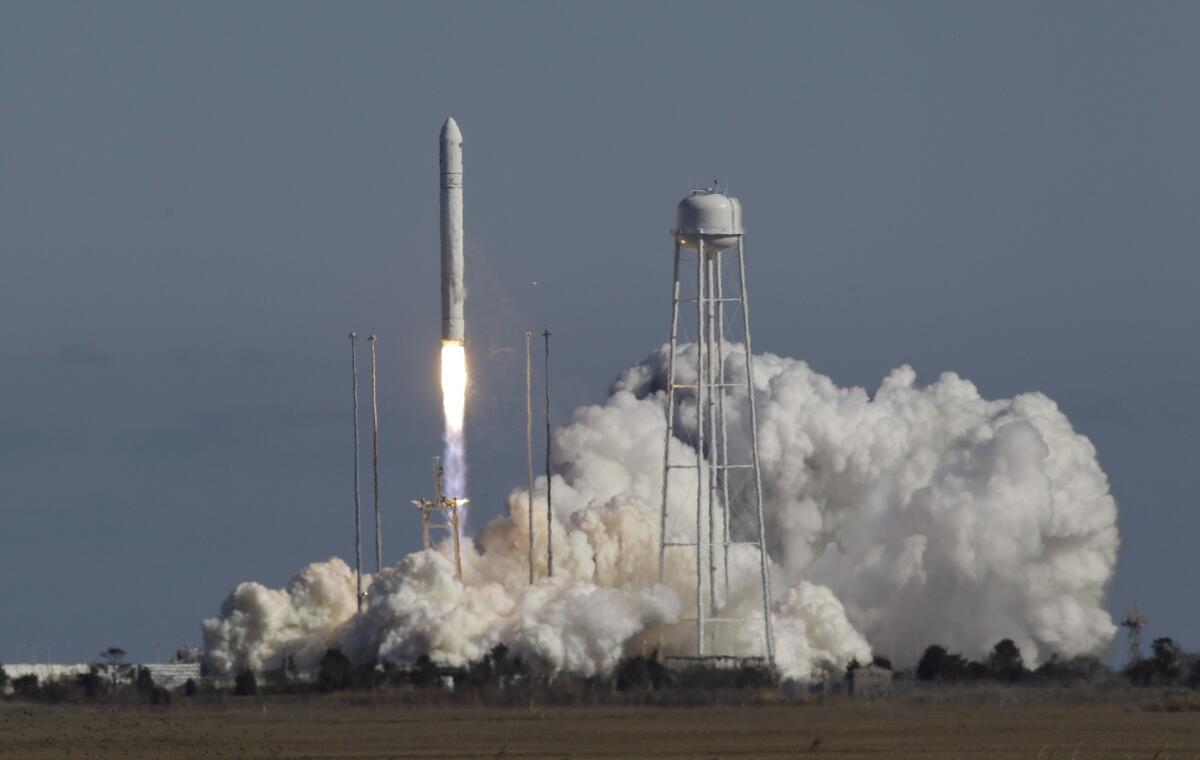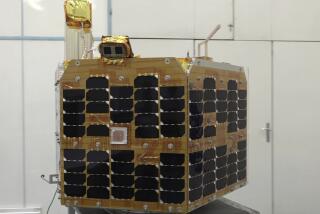Antares rocket blasts into orbit for first time in test for NASA

- Share via
In its maiden flight to space, a commercially built 13-story rocket blasted off from a launch pad off the coast of Virginia in a test mission for NASA.
The Antares rocket, developed by Orbital Sciences Corp., roared into orbit after launching Sunday at 2 p.m. Pacific time from the newly built Mid-Atlantic Regional Spaceport at NASA’s Wallops Flight Facility.
PHOTOS: Orbital Sciences sends Antares to orbit
Although it was simply a test flight to reach orbit, the successful launch was another crucial step in NASA’s plan to hand off space missions -- carrying cargo and crews -- to private industry now that the space shuttle fleet has been retired.
“Today’s successful test marks another significant milestone in NASA’s plan to rely on American companies to launch supplies and astronauts to the International Space Station, bringing this important work back to the United States where it belongs,” NASA Administrator Charles Bolden said in a statement.
NASA has invested about $288 million in seed money to help the Dulles, Va., company develop its technology, and has an additional $1.9 billion on the table with a contract for eight flights to transport cargo to the International Space Station in the coming years.
Antares’ launch was scheduled to take place Friday, but was delayed because of technical issues. High winds postponed the blastoff from Saturday to Sunday.
It was a picture-perfect launch from Wallops, with the Atlantic Ocean lapping against the surf in the near distance.
When the engines first ignited, the white rocket did not lift off from the pad for two full seconds because of its design. After 60 seconds, the vehicle was at more than 3 miles in altitude but still subsonic -- about 460 mph.
It wasn’t until about nine minutes into the mission that the rocket was in orbit, at 155 miles in altitude and moving at 17,000 mph.
The two-stage rocket, powered by engines from Aerojet-General Corp. in Sacramento, carried a dummy cargo capsule weighing roughly 8,300 pounds about 160 miles above Earth.
The capsule has instruments onboard to collect data and will remain in orbit for months until natural gravitational forces slowly degrade its orbit and it reenters the atmosphere and burns.
The Antares test flight, more than a year late because of design and launchpad delays, is the first of two missions Orbital is scheduled to conduct in 2013 under its contract with NASA. It hopes to visit the International Space Station later this year.
One commercial company, Space Exploration Technologies Corp., has successfully resupplied the space station in two missions. The Hawthorne firm, better known as SpaceX, most recently pulled off the feat last month.
Orbital employs about 3,600 people -- about 200 of whom are in California at Orbital’s offices in El Segundo and Huntington Beach and at Vandenberg Air Force Base.
The company was founded in 1982 and manufactures more than half a dozen small- and medium-class rockets, as well as satellites.
The publicly traded company had about $1.5 billion in revenue last year.
Part of Orbital’s selling point -- and what has attracted the government’s attention -- is the company’s assertions that it can develop and launch rockets at a fraction of the cost of the current generation of spacecraft.
Unlike SpaceX, Orbital does not have a space capsule that can return with cargo. It burns up in the Earth’s atmosphere. Nor does it have an astronaut-capable version of the capsule in the works.
For now, company officials said they were content running resupply missions.
ALSO:
FAA approves fix for Boeing 787 battery
U.S. to mount drone-zapping laser on Navy ship [VIDEO]
Boeing offers voluntary buyouts to employees in its space division
More to Read
Inside the business of entertainment
The Wide Shot brings you news, analysis and insights on everything from streaming wars to production — and what it all means for the future.
You may occasionally receive promotional content from the Los Angeles Times.











